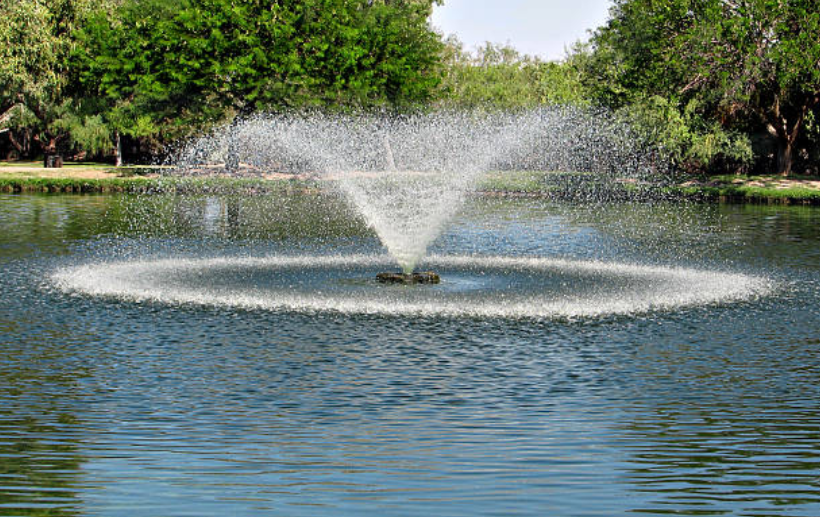Choosing the Right Pond Fountain for Your Backyard or Property

A water element can change the entire ambiance of a place. Quiet movement. Gentle sound. The way the spray is lighted. It appeals to people. But the selection of pond fountains is not so simple.
It comes in size, depth, spray pattern, pump strength, and maybe some trepidation of choosing the wrong one. Is it suitable for your pond? Will it get plugged in? Will it keep algae away, or will it just be pretty?
The thing is that most of the people are unaware of what they need. They just want it to work. And they want it to be forever. Here, the experience of pond fountains starts to pay off.
What Does a Pond Fountain Actually Do?
A pond fountain pulls water from beneath the surface and shoots it into the air. Some sprays are narrow and tall. Others are wider, more decorative. But they all serve the same basic function: movement.
Why movement? Still, water stagnates. Algae builds up. Mosquitoes thrive.
Moving water stays healthier. And a fountain, if sized right, keeps it moving all day.
How Big Is Your Pond?
This matters more than anything else.
Too many fountains for a small pond look… off. It can overpower everything around it. Too little water in a large pond just disappears.
Here’s a rough idea:
- Small ponds (under 500 gallons): Stick with a compact, low-spray fountain. Submersible pumps are easier to install.
- Medium ponds (500–2,000 gallons): Look for moderate spray height and a pump that can handle some debris.
- Large ponds (over 2,000 gallons): You’ll need higher GPH (gallons per hour) and potentially a floating fountain system.
Always check the GPH rating of the pump. That tells you how much water it can move, and it needs to match your pond size. Bigger isn’t always better, but too small is just asking for disappointment.
Submersible or Floating?
Submersible fountains are easy. They sit at the bottom of the pond and run quietly. Suitable for smaller or medium ponds.
Floating fountains work differently. They sit on the surface, pulling water up through a pump suspended below. They’re better for larger ponds or uneven bottoms.
You’ll also need to think about:
- Power access. Submersible pumps often use less power, but floating systems might require a longer cord or extension to reach the center.
- Maintenance access. Floating systems can be easier to lift out and clean.
No option is perfect. Just depends on what matters more to you—installation or appearance, access or stability.
See Also: Localize Right with English to German Translation Services
Spray Pattern: Looks or Function?
Some people want drama—a tall, narrow spray that’s visible from the road.
Others prefer broad, low spray patterns that blend in more.
Functionally, both help with oxygenation. But there’s something about watching the spray at dusk, light-catching every droplet. It sticks with you.
Common spray patterns:
- Geyser-style: Tall and narrow. Impressive, but it can drift with the wind.
- Fan or tulip-style: More decorative. Less splash, better suited for windy areas.
- Multi-tiered: Adds texture but can clog faster if the water isn’t filtered.
Pick what fits your space. And maybe your mood.
Think About Debris
If your pond has a lot of leaves, muck, or floating weeds, a fountain can clog easily. It’s frustrating.
Look for pumps with:
- Debris screens or pre-filters
- Easy access for cleaning
- Durable impellers that won’t jam up every week
And if the area around your pond is shaded by trees, expect more maintenance. It’s not a dealbreaker, just reality.
Do You Need a Fountain or an Aerator?
It’s easy to confuse the two. Both move water, but in different ways.
- Fountains spray up into the air. Visually appealing, some oxygenation.
- Aerators push air into the water, often from the bottom. Better for deeper oxygen coverage.
If your pond is primarily decorative, a fountain is probably enough.
If fish health or algae control is a top concern—especially in warmer months—you might need an aerator or a combo system that does both.
Sometimes, people buy a fountain, thinking it’ll solve all water issues. It might help, but it’s not magic.
Installation: More Work Than Expected?
Maybe. Maybe not.
Most submersible fountains are plug-and-play. Drop them in, run the cord out, and plug them into a GFCI outlet. Done.
Floating systems can take a little more planning:
- Anchoring might be needed to keep it centered.
- Cord length becomes an issue with bigger ponds.
- Power access may require outdoor-rated extensions.
None of this is hard. But it’s the kind of detail that surprises people, especially if you’re doing it alone.
What Do You Actually Want?
This gets overlooked.
Do you want it to be quiet? Eye-catching? Low-maintenance? All three?
Here’s what most people actually care about:
- Does it look good without being flashy?
- Can I leave it running without checking it every day?
- Will it help keep the water clean or just add noise?
- Is the pump going to fail in a year?
Try not to guess. Look for real user reviews, basic warranty info, and honest answers from whoever you’re buying it from.
You don’t have to be an expert. But you shouldn’t be totally in the dark, either.
Conclusion
The proper pond fountain balances form and function. It fits your space, looks the way you want, and doesn’t give you a headache to install or clean.
It’s not about buying the most powerful or expensive thing on the shelf.
It’s about understanding what your pond actually needs—and picking something that quietly, consistently does the job.
Simple as that.



